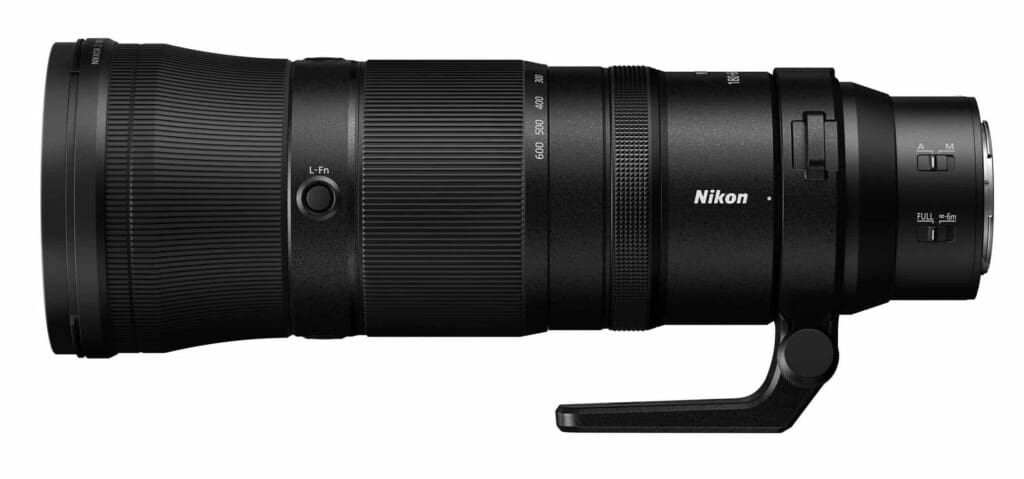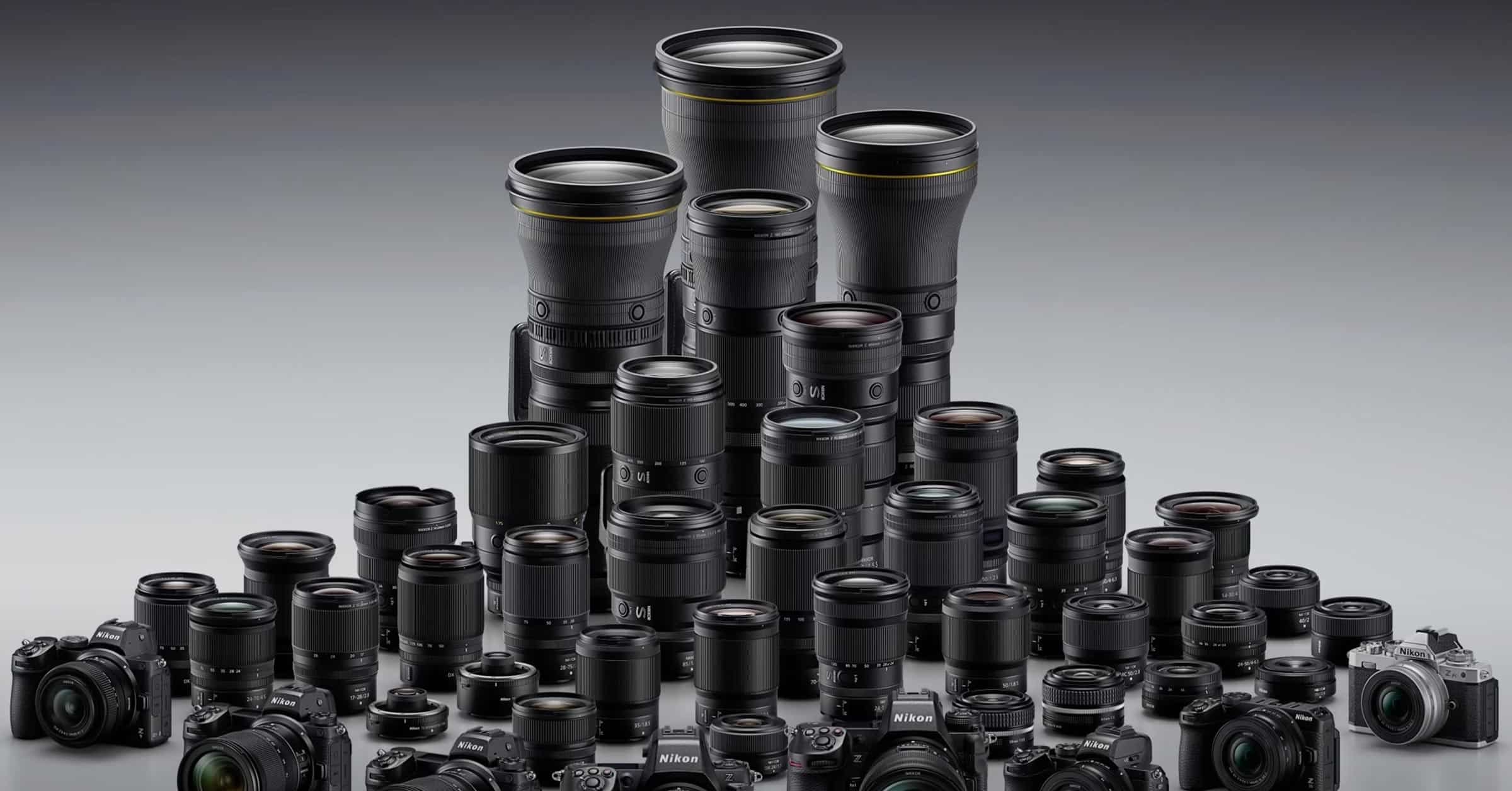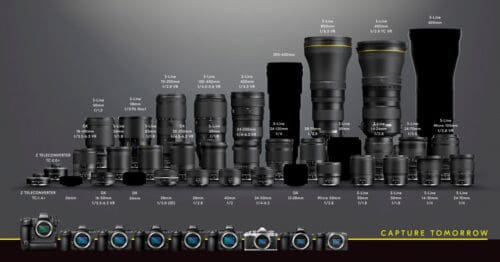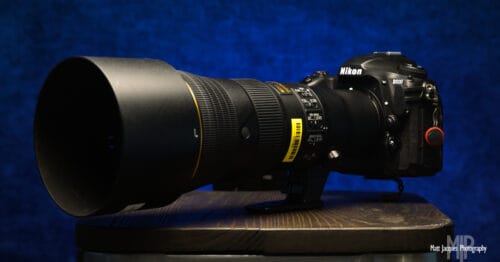When rumors started that Nikon was preparing a Z 600mm f/6.3 lens for launch, I was surprised. Even without such a lens in the lineup, Nikon had the most substantial range of telephoto options for any manufacturer by quite some margin. Did the Z lens lineup really need another telephoto option that overlaps specifications with several already-existing, excellent lenses? Until the lens was officially unveiled, I found it hard to believe. Why this lens and not a tilt-shift lens, a longer focal length macro, a 300mm f/2.8, or an ultra-wide? Those are the gaps Nikon lens range. Those are the lenses I see people asking for.
I’m Not Saying 600mm Isn’t Useful
The first Z Mount PF lens, the Nikon Z 800mm f/6.3 PF VR S, is a great success. It’s a lens I own and have enjoyed using since its release. When it was first launched, everyone was amazed by how small and light it is, physically and financially, on your wallet – at least for an 800mm lens. The trouble is that 800mm is a very long focal length. While I have found it to be great for bird photography, it can be too long for wildlife photography of larger mammals. Aha! You say. You need this new Z 600mm f/6.3 VR S. Well, no. Not really. At least not in the field alongside my 800mm f/6.3. When I need something shorter than 800mm, I turn to the stunningly sharp Nikon Z 400mm f/4.5 S VR and find the 400mm + 800mm combo helpful.
Is the 600mm focal length a nice middle ground between the two? Yes, it certainly can be. I own and enjoy the Sony 600mm f/4 GM lens. Still, I feel a bit naked in the field if I don’t have a second lens alongside a 600mm. That means anyone buying the Z 600mm f/6.3 must still consider carrying a second lens like the Z 100-400mm, Z 70-200mm, or Z 70-180mm.
A Case For the Nikon Z 400mm f/4.5 VR S + 1.4x Extender (560mm f/6.3)
The Z 400mm f/4.5 S VR is one of my all-time favorite telephoto lenses. It doesn’t get enough love because many photographers buy the Nikon Z 100-400mm lens instead, preferring focal range flexibility over critical sharpness with and without teleconverters. I own the 100-400mm lens, too. It’s good but not as sharp as the 400mm f/4.5 lens, particularly with the 1.4x and 2x extenders.
Importantly, the Nikon Z 400mm f/4.5 lens works incredibly well with the Nikon Z 1.4x extender. I’d go so far as to say that it’s one of the best lens+extender combinations I have ever used, including my Canon and Sony kits, not just my Nikon kit. When looking through photos shot with this combination, I always have to refer to the EXIF focal length info to determine whether I was using the extender.


With the 1.4x extender in place, the Nikon 400mm f/4.5 becomes a 560mm f/6.3 and still weighs only 3.23 lbs (1456g). The cost of this combination, at today’s MSRPs, would be $3795. You can see why I’m asking questions, can’t you? The Nikon lens lineup already has the most diverse collection of telephoto lenses on the market. Why would they need to add a 600mm f/6.3 PF lens when there is already a very sharp 560mm f/6.3 lens for a lower price? The new 600mm f/6.3 VR S weighs 3.1 lb (1390 g), so yes, it is 0.1 lbs (66g) lighter. But you must pay $1000 more for that fractional weight saving than buying the 400mm lens and the extender.
And then there’s the question of image quality and bokeh. PF lens design technology is a great way to shed some weight and lens length from a typical design, but you pay an IQ price. The current 800mm f/6.3 PF lens isn’t as sharp as the 400mm f/4.5 lens and also suffers from “busy background syndrome” in some cases. PF lenses don’t produce the same super-smooth, creamy bokeh of a regular lens design. The issue doesn’t always show up, but when it does, it can be a letdown.
At best, I’d be surprised if a Nikon 600mm f/6.3 VR S matched the sharpness and bokeh quality of the 400mm f/4.5 + extender combination. You’re also stuck at the 600mm (or more) focal length, where the 400mm f/4.5 + extender combination always allows you to use the native 400mm focal length – another oft-used focal length for wildlife photography.
Related Posts – Nikon Z 600mm f/6.3 VR S
What About the Nikon 180-600mm f/5.6-6.3 VR?

The other elephant in the room is the existence of the Nikon Z 180-600mm f/5.6-6.3 lens. At the long end, this lens delivers 600mm @f/6.3 – precisely the same as the new Z 600mm f/6.3 lens. This zoom lens weighs 4.3 lb / 1.95 kg, so the prime 600mm f/6.3 PF comes in a little lighter but at nearly 3x the price. How many people would choose the less flexible prime lens that costs $4800 compared to the still-very-good and much more flexible 180-600mm zoom for $1800?
Final Thoughts
Don’t misunderstand me, I’m not saying the Z 600mm f/6.3 lens is a bad idea. I’m sure it’ll succeed, and I might even buy it myself. I’m just surprised that Nikon created a lens that overlaps so much with existing lenses while there are other more obvious gaps in the Z lens lineup. If there was one area that nobody complained about, it was the lightweight, affordable telephoto segment.
I guess choices are good to have. Still, I now expect to field many questions from confused Nikon users trying to decide between the Z 180-600mm f/5.6-6.3, the Z 400mm f/4.5, the Z 600mm f/6.3, and the Z 800mm f/6.3. Throw the Z 100-400mm in the mix while you’re at it.
What is needed in the Z lens lineup is a 300mm f/2.8 to compete with Canon’s 100-300mm f/2.8 zoom and Sony’s 300mm f/2.8 prime lens, along with more APS-C lenses and some specialty full-frame lenses such as tilt-shifts and a fisheye. I hope we see them soon.













Hi Dan,
I won’t argue your logic. All I’ll say is, this Canon wildlife shooter thinks it must be great having so many fantastic — and affordable — lenses in the telephoto range. To date, Canon has all but ignored the very prosumer group that Nikon is ‘spoiling.’ I’m very seriously considering changing to Nikon, solely for the lineup of prosumer wildlife lenses. Best regards.
You’re right, Michael. I don’t understand Canon’s logic. There are strong rumors that Canon is developing a 200-800mm f6.3-8 lens alongside the almost-certain mega-expensive RF 200-500mm f/4 L; however, the rumors also suggest this cheaper 200-800mm lens will still be a proper L-Series lens, which will mean a high price even if it doesn’t have a fast aperture. When the Canon RF 100-500 is already $500 more than Canon and Nikon’s 200-600mm lenses, it would seem hard for a Canon 200-800mm to compete with them on price. I wouldn’t blame a switch. The Sony 200-600mm value has long been a reason to switch to that platform, and now the Nikon 180-600mm delivers a similar reason.
The RF 100-500 has a strong case for itself to justify it’s pricing. Way smaller and lighter with excellent MFD and high magnification. It is also sharp corner to corner for landscapes (at least as good as a 100-400 by Nikon/Sony) and the AF is super fast for shooting sports. It does many things (which of course someone might not need as opposed to a better reach or faster aperture).
As for the Z 600/6.3, there is definite use case for it if someone loves the 600mm focal length, it is likely to better the Z 400/4.5 1.4x with regards to AF and sharpness. Whether that’s worth the extra expensive, we’ll see.
If the demand really won’t be that high because of the aforementioned reasons, then they are simply going to drop the price, all the better for us.
You’re not wrong about the 100-500mm. My Canon kit isn’t huge, but I have that lens and like it very much. It’s better than the Sony or Nikon 100-400mm lenses IMO.
As for the 600mm, I’m certainly curious about it. No doubt I’ll try it! I do love the 400mm f/4.5 so much, though! We shall see. Choices are good to have, I just worry that Nikon are confusing people a little.
I do not think it is any more confusing than choosing between 400/2.8 and 600/4, just at a lower level. (And with Nikon, there is a cherry on top with built-in converters.)
Is it more important to have as much flexibility as possible regarding the maximum aperture, angle of view and MFD? Or is it best to be more focused on one focal length without faffing with converters to maximise image quality (or to have more reach with those)?
The choice is up to the users, really. Plenty of variables with regards to subject and location (distance).
But on the ‘top level’, it seems that most wildlife shooters (without budget constraints) prefer 600mm over 400mm, 500mm or 800mm primes, which explains the 600/6.3.
While I was super impressed with the 100-500/4.5-7.1 myself, in the end, I didn’t utilise it (the size, weight, aperture, MFD of the 70-200/2.8 might have been a better addition), going back to the 800/11 for now.
I know, blasphemy, but until I figure it out, it’s ok (plenty of limitations, but I still need to outgrow it first). Since IBIS is not supported, I can scale back to an R8 from an R6 II to have a featherweight duo with a body permanently attached with better AF coverage. Biggest problem is the MFD, can’t do much about it. (Small thing, but it’s nice of Nikon to improve it a little with the 600/6.3 and 800/6.3.)
All good points. And my preferred wildlife lens is my Sony 600mm f/4, so I have nothing bad to say about the focal length. But I’m also in the lucky position to be able to justify owning several lenses that suit different needs on the day or trip. The people to whom Nikon will sell the majority of these lenses will not be the sort of people who can buy a whole arsenal of lenses. In that case, I think you can make a very good case for the 180-600mm or the 400mm f/4.5 + 1.4x for the flexibility they deliver.
I’ve extensively used both lens configurations—specifically, the 400mm with a 1.4x TC and the 800mm—and can affirm the findings mentioned in the article. However, I’d like to add a note regarding the comparison made by Photography Life, which suggested the 800mm might be less sharp. This conclusion was drawn from a test chart, not real-world photography. In my practical experience, the 800mm lens delivers exceptional sharpness, particularly after post-processing the Raw files. I tend to adjust the sharpness sliders to a lower level because excessively sharp images can lose their natural beauty.
Regarding the 400mm with the 1.4x TC, it performs admirably. I share your curiosity about the necessity of adding a 600mm PF lens to the setup—its value proposition remains unclear. In my opinion, the 400mm and 800mm configurations effectively cover a broad range of needs.
Best regards,
Peter
Well, your title did suck me in to reading this. You make one really valid point–the price of the new pf lens is hard to justify over that of the 400mm 4.5 + TC. And, the 4.5 lens gives you the flexibility of shooting 400mm and 560mm–if you are willing to deal with putting on and taking off TCs. The rest of your points would have been more credible if you had actually handled, used, and tested the new pf. Without that, your claims are simply unsupported beliefs that lack credibility.
First, you make the wild claim that the 800mm is less sharp than the 400 4.5. Where does claim come from? If you look at the MFT charts, both lenses’ S10 curves are almost perfectly flat at 1, with the S30 curve for the 800mm nearly as flat. The S30 curve for the 400mm lens is noticeably lower, but not enough to claim one lens is sharper than the other. Did you get a bad copy of the 800mm? My copy is extremely sharp with excellent bokeh. Too bad your copy isn’t.
As for the 600mm pf, I’ve been testing it for the last couple of days. I alway found 400mm a little short for birding, or shooting any wildlife at a distance, so 600mm has an allure for me. I do have the 400mm 2.8 TC, but sometimes that lens is a bit more than I want to take when I need to be mobile or am on an extended hike. So that’s my reasoning for considering this expensive addition. Thus far the pf lens is amazingly sharp, the bokeh is plenty creamy (albeit, it won’t compete with the bokeh of a 400mm 2.8 lens), and the size and handling is amazing. I had the Sony 200-600, which is almost identical in size and handling to the new 180-600mm. That big and bulky monster was no fun to use. I suspect the Nikon is much the same. Also, the reviews I’ve seen indicate that IQ for the twins is similar with the Sony maybe a smidge sharper at 600mm. If true, the Nikon is just not at the same level as the new pf lens. Neither lens approach the sharpness at 600mm that the new pf lens achieves.
Of course, if your budget can’t stretch to include the 600 pf, there’s nothing wrong with the new zoom. The 600 pf is an exotic prime and quite possibly the sharpest pf lens ever. But if you can afford the pf and value 600mm, the 180-600mm is no slouch.
In short, why don’t you try the 600 pf and then consider editing or rewriting your article.
“Without that, your claims are simply unsupported beliefs that lack credibility.” – They are never presented as fact, always conjecture, so I don’t know what your point is. And I’d argue they are as substantiated as they can be, considering the article was written when the 600mm PF was not available and that I do own all the other lenses I’m comparing it to: 180-600, 100-400, 400mm f/4.5 and 800mm PF. Don’t you think it’s better to read the comments of someone like me who owns all those lenses than someone who owns none of them? And guess what? The 600mm PF will be in my hands in a few days. So maybe just cool your jets or take your negativity elsewhere.
“First, you make the wild claim that the 800mm is less sharp than the 400 4.5. Where does claim come from?”
It comes from the fact that I own both these lenses! My 800mm PF copy is excellent. In fact, I have gone to bat for that lens when other reviewers have criticized its sharpness. It doesn’t sound like you own the 400mm, so you are arguing a point for which you have no experience. Something, something, something… credibility… didn’t you say earlier?
My own claims are also confirmed by Photography Life’s excellent recent Nikon telephoto group test where they concluded that the 400mm f/4.5 with a 2x extender on it has the same sharpness as the 800mm PF. So, clearly, without the 2x extender, the 400mm was sharper than the 800mm. I’ll let you Google that test and leave them disgruntled comments, too.
And what exactly is your issue with that statement anyway? 400mm and 800mm lenses are nowhere near useful for the same thing, so I’m guessing you somehow feel put out that there might be a lens that is sharper than your 800mm but costs less? Even though they are not used for the same thing? It’s kind of like getting annoyed that the 135mm Plena is sharper than your 800mm. What’s the point?
“In short, why don’t you try the 600 pf and then consider editing or rewriting your article.”
I never said I wouldn’t. In fact, I think I had already ordered it when I published the article. Even if I enjoy it and decide to keep it, I will always say, “Did we need it?”. And I never stated anything in this article that was categorical about the image quality or the 600mm PF. Nowhere does it say that any specific lens is sharper or less sharp than your precious 600mm PF. Nothing to rewrite, as far as I can see. This was an article written as commentary after a lens announcement and never even remotely positioned as some kind of review or critical opinion of the 600mm PF.
Geez, Robert. I hope your day gets better. The internet doesn’t create content simply for you to feel validated about the purchases you have already made. You say you like the lens, and I probably will too. Can’t you just go and enjoy it without spreading this muck?
Hi Dan,
I tried the Nikon Z 180-600mm f/56.-6.3 on my Z9. However, it was with a version of Lightroom Classic that introduced a lot of noise. I initially thought it was the lens. So, I returned it. Then, I purchased the Nikon Z 600mm f/6.3 PF and a copy of Capture One Pro. After taking photos with both lenses and comparing results in Capture One Pro, I actually believe the 180-600 produces sharper images. Is that possible? At the time I purchased the 600 PF lens, my local camera shop did not have the Z 400mm f/4.5. Would I be better off with the 400 or 180-600? I still have time to return my 600 PF.
Thank you.
JP
Dan you need to update this article. I have tested the 400 f4.5 both with the 1.4tc and without. The bare 600 f6.3pf is sharper than either combination! I would say of your using the 400 f4.5 with the TC even 50% of the time, your better off with the 600pf. Both are great… but the 600pf is the better lens. Also, look up Steve perry’s comparison between these two lenses. Steve concurs the 600pf has spirit IQ ( near identical to the 600 f4 TC! )
Doesn’t the answer depend on your use case? I just got back from a national park photographing medium to large mammals and birds, and enjoyed great opportunities for both. I relied mostly on two lenses – the 100-400 and the 600 f/6.3 – and paired the 600 with a 1.4 TC when the subject was very far away relative to its size. That gave me loads of flexibility, from 100 to 800, and all of it really good glass.
If I’d carried the 400 f4.5, that kind of flexibility would have required another lens – either to go longer than 560 or shorter than 400. If you don’t need the long end, that doesn’t matter, but for me it would have meant giving up the option of 840mm and required cropping in more than I would have liked for several shots. Even big critters sometimes don’t let you too close. And as the poster above said, the 600 f/6.3 plus TC was awfully good.
All’s not perfect, of course – adding the TC to the 600 gives you f/9 as your widest aperture, which can be a problem in dim light – but until I can afford the price and weight of the 600 f/4 (probably never…) it it’s a happy enough result.
“Doesn’t the answer depend on your use case?” Always, to some extent. The point of this post was just to express surprise that this was a lens they made at that point in time. I like the 600 6.3 very much. I own it myself and think it pairs nicely with the 100-400.